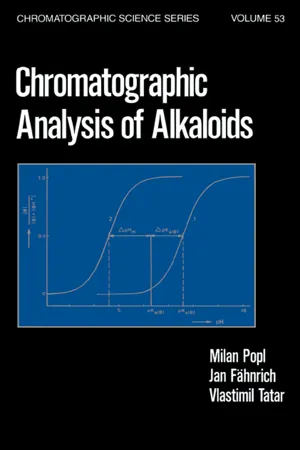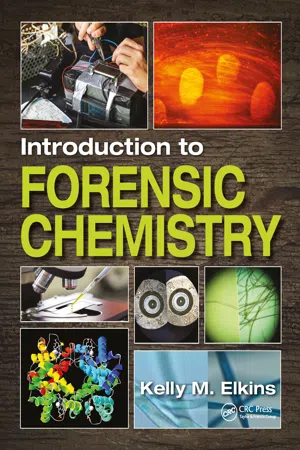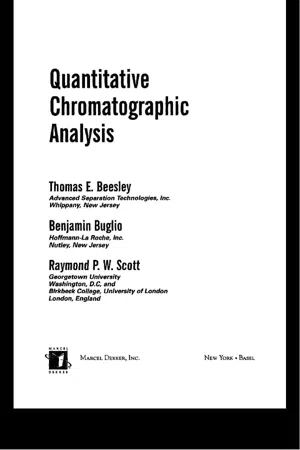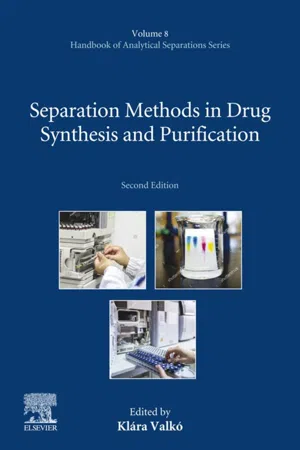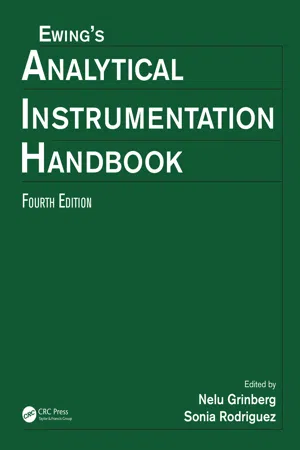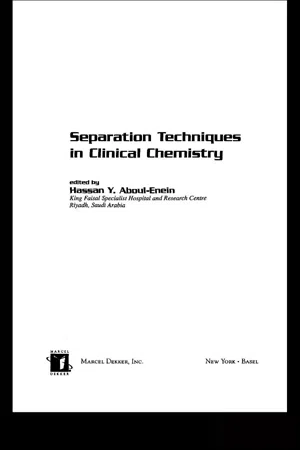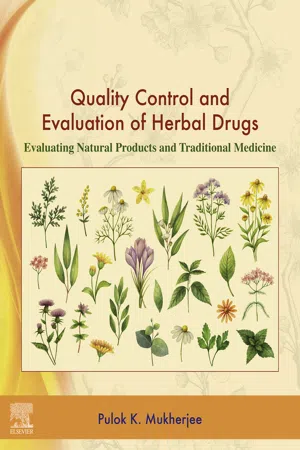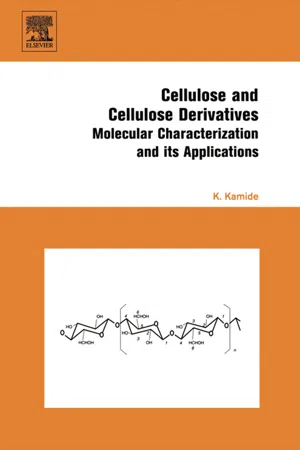Chemistry
Thin-Layer Chromatography
Thin-layer chromatography (TLC) is a chromatographic technique used to separate and analyze mixtures. It involves the use of a thin layer of adsorbent material on a flat support, where the sample is applied and then separated as it moves up the plate through capillary action. TLC is commonly used in chemical analysis for its simplicity, speed, and cost-effectiveness.
Written by Perlego with AI-assistance
Related key terms
Related key terms
1 of 4
Related key terms
1 of 3
11 Key excerpts on "Thin-Layer Chromatography"
- eBook - ePub
- Milan Popl, Jan Fahnrich, Vlastimil Tatar(Authors)
- 2018(Publication Date)
- Routledge(Publisher)
6 Thin-Layer ChromatographyIn contrast to paper chromatography, which is used rarely nowadays due to its low speed and efficiency, Thin-Layer Chromatography (TLC) is well established and widely used in various fields of analytical chemistry (1 , 2 , 3 , 4 , 5 , 6 ). Because quantitation with this technique is not straightforward, its long-time domain has been qualitative analysis. Besides giving retention data, the chemical reactions with various reagents performed directly on the sorbent layer can easily be used for the identification of unknown samples. Identification can rely on a large amount of data accumulated in the past. An extensive summary of alkaloid TLC was completed by Baerheim Svendsen and Verpoorte (7 ). For identification purposes the preferred separation systems are those in which retention data for a great number of compounds have been established. Unfortunately, only a few systematic studies cover more than hundreds of compounds. As an example, the important systems for drug identification can be mentioned here. Many TLC data for drugs were accumulated in early studies (8 ). A compilation of TLC data (9 ) enabled completion of a computer-based identification system utilizing TLC, GC, and spectral data (10 ) with 1600 drugs included in this data base. A dissimilarity index was used to match unknown samples with the data file. Another approach utilizes principal component analysis of RF values for 362 drugs in four separation systems using silica gel layers (11 ). Quantitative analysis using TLC, although more difficult, is gaining importance. With suitable equipment the accuracy of determination may be comparable to that of other chromatographic methods.I. TECHNIQUE OF TLCAs far as laboratory equipment is concerned, TLC is the simplest chromatographic technique. Essentially only suitable vessels containing mobile phase and precoated plates are required in order to perform separations. Even in that way TLC possesses numerous advantages over column chromatography. Several samples can be analyzed simultaneously in a single run. Since chromatographic plates are used only once, samples with a relatively complex matrix can be separated, in contrast to column liquid chromatography, in which column contamination is to be avoided. Far simpler purification steps are therefore satisfactory. All components of the sample are detectable on the TLC plate. Strongly retained components eluted as broad peaks, difficult to detect, or not eluted at all in column liquid chromatography are in TLC concentrated in small spots near the start and can be sensitively detected. With certain precautions TLC can be used as a pilot technique for solvent system selection in column chromatography. The possibility of two-dimensional separation multiplies the resolving power of the TLC, making possible the analysis of complex mixtures. - eBook - ePub
Practical Thin-Layer Chromatography
A Multidisciplinary Approach
- Bernard Fried(Author)
- 2017(Publication Date)
- CRC Press(Publisher)
in situ quantification. In great measure, these notable advances can be attributed to technological advances in laboratory equipment and instrumentation. TLC is considered to be an ideal chromatographic system for clinical laboratories. It is used clinically as an aid in diagnosis. The relative simplicity of the method and inexpensive cost of operation make it the method of choice in clinical chemistry.II. HISTORICAL ASPECTS OF TLCChromatography is a generic term for a technique that allows separation of a mixture of compounds. Chromatography received its name from the work of a Russian botanist named Michael Teswett in 1906. The basic principles of Thin-Layer Chromatography were first described by Izmailov and Shraiber in 1938. Although Consden et al., Kirchner, and Kelley had experimented with a variety of layers and surfaces, the TLC methodology using fine-grained silica gel particles was developed by Stahl et al. and Randerath. Several comprehensive texts1 − 7 are now available on TLC techniques. The effort here is not to replace the existing reviews and books available on TLC technique, but to outline recent developments of this technique and its application in clinical chemistry.III. PRINCIPLES OF TLCThin-Layer Chromatography has been in use for more than the past 40 years. Today, it is one of the most widely used separation methods. It is a physicochemical separation method, in which the components to be separated are distributed between two phases. One of these phases constitutes a stationary phase of large surface area and the other is a mobile phase that traverses along the stationary phase. The components to be separated are differentially attracted to the stationary phase because of variation of their physicochemical properties. This distinctive influence is manifested by different rates and distances migrated. Substances that are less strongly held on the stationary phase would tend to move faster in the mobile phase and vice-versa. In other words, the speed of migration of a particular component would depend on its sorptive affinity to the other component present. - eBook - ePub
- Kelly M. Elkins(Author)
- 2018(Publication Date)
- CRC Press(Publisher)
October 16, 2011, USA Today. https://usatoday30.usatoday.com/sports/college/mensbasketball/2011-10-16-1691565843_x.htm (accessed January 27, 2018). Chromatography is a technique used to separate components of a mixture by their physical properties including polarity, boiling point, solubility, size, charge, and structure. In chromatography, there are two phases: the mobile and the stationary phase. Mixture components are separated by exploiting the differences in their strengths of interaction with the two phases such as adsorption or binding to the stationary phase and solubility or gas state in the mobile phase. There are several types of chromatography including paper and Thin-Layer Chromatography (TLC) that are named for their stationary phases. Other types, including gas chromatography (GC) and high-performance liquid chromatography (HPLC), have names that reflect their mobile phases. Thin layer, paper, column, and liquid chromatography are all types of liquid chromatography. Column chromatography methods include GC, gravity column chromatography, fast protein liquid chromatography (FPLC), HPLC, and ultra-performance liquid chromatography (UPLC). Thin-Layer Chromatography TLC is a simple and inexpensive method for separating sample mixtures. TLC typically employs silica [SiO 2 ] n or alumina (Al 2 O 3) as the stationary phase. A thin veneer of the silica or alumina is spread on glass or plastic plates (inert supports) that can be cut to the desired size and dimensions. The stationary phase is more polar than the mobile phase. Silica is used in the separation of polar compounds and the alumina is used to separate less polar or nonpolar compounds. The mobile phase is an organic solvent or mixture of organic solvents in desired proportions. The mobile phase (approximately half a centimeter) is added to a beaker, jar, or other developing chamber that is covered with a glass lid or watch glass - eBook - ePub
- David G. Watson(Author)
- 2020(Publication Date)
- Elsevier(Publisher)
- • The number of theoretical plates available for separation is limited in routine TLC systems, although high-performance TLC (HPTLC) plates can offer nearly the same efficiency in a 10-cm distance as an HPLC column of the same length.
- • Sensitivity is often limited.
- • Not suitable for volatile compounds.
- • Requires more operator skill for optimal use than HPLC.
Introduction
Thin-Layer Chromatography (TLC) has developed into a very sophisticated technique for identification of compounds and for determination of the presence of trace impurities. Since it was one of the earliest chromatographic techniques, a huge array of TLC-based tests is available and pharmacopoeial monographs reflect the extent to which this technique has been developed as a fundamental quality control technique for trace impurities. The reason for its prominence in this regard is due to its flexibility in being able to detect almost any compound, even some inorganic compounds. Following TLC, the entire chromatogram can be seen, and thus there is no doubt over whether or not components in a sample have failed to elute from a chromatographic system, as is the case with HPLC and gas chromatography (GC) and even capillary electrophoresis (CE). In this short chapter it would be impossible to outline all of the tests that can be used; comprehensive reviews of the technique have been written.1,2Even the most advanced form of TLC, high-performance TLC (HPTLC), remains essentially a simple technique. The sophistication in the application of the technique derives from the broad choice of stationary phases, mobile phases and the wide range of spray reagents which can be used for visualizing the chromatogram.The advances in the technology of the technique have been recently reviewed,3and these include the use of high-pressure TLC and interfacing with detection systems such as Raman spectroscopy and mass spectrometry.Instrumentation
Fig. 13.1 shows a simple Thin-Layer Chromatography apparatus (Animation 13.1 ). The most frequently used system is a glass or plastic plate coated with silica gel; for routine applications the silica gel particle size is in the range 2–25 μ - eBook - ePub
- Raymond P.W. Scott(Author)
- 2020(Publication Date)
- CRC Press(Publisher)
The great advantage of TLC is its low cost and its relatively high separating capability. If the performance required to separate a sample is at the limit or beyond the capability of the technique, there is no point in trying to stretch the technique merely for the sake of the technique itself. The rational solution for the chemist or analyst would be to change to an alternative procedure such as liquid chromatography or to some other technique that is more appropriate.References
1 / M.S.Schreiber, “75 Years of Chromatography-an Historical Dialogue”, Elsevier Scientific Publishing Company, Amsterdam-Oxford New York (1979)413.2 / J.G.Kirchner, “75 Years of Chromatography-an Historical Dialogue”, Elsevier Scientific Publishing Company, Amsterdam-Oxford-New York (1979)201.3 / J. E. Meinhard and N. F. Hall, Anal. Chem., 21 (1949)185.4 / J. G. Kirchner, J. M. Miller and G. J. Keller, Anal Chem., 23 (1951)420.5 / J. G. Kirchner, J. M. Miller and R. G. Rice, Agr. Food. Chem., 2 (1954)1031.6 / E. Stahl, Chem.-Ttg., 82 (1958)323.Passage contains an image
Chapter 15
THIN LAYER CHROMATOGRAPHY TECHNIQUES
In TLC the separation process and the mechanism of retention is exactly analogous to those involved in LC except that the stationary phase is in the form of a laminate sheet, whereas in LC it is in the form of a cylindrical packed bed. Furthermore, as already discussed in the previous chapter, in TLC the flow of mobile phase is driven by surface tension forces and not by fluid pressure. As in LC, the vast majority of TLC separations are carried out employing silica, or silica based material as the stationary phase. However, there are a significant number of alternative materials that have been employed for special separations but few of them have achieved common use. Some of these alternative stationary phases will be briefly discussed. - eBook - ePub
- Thomas Beesley, Benjamin Buglio(Authors)
- 2000(Publication Date)
- CRC Press(Publisher)
Part 4 Thin Layer ChromatographyPassage contains an image
Chapter 10 Thin Layer Chromatography Apparatus
Thin layer chromatography is not the ideal chromatographic system for accurate quantitative analysis. The technique can be an excellent tool for qualitative work and for scouting different mobile phase systems for liquid chromatography [1] . It is also the only chromatographic technique which presents a complete profile of the separation and, as a consequence, reveals the extent to which elution is complete. The main advantage of the technique, however, resides in its low cost, but to ensure adequate accuracy and precision in quantitative assays, expensive scanning apparatus is usually necessary which undermines the intrinsic low cost advantages of the technique. Thin layer chromatography appears to have been first developed and utilized by Schraiber in 1939 [2] , who, working with Izmailov at the Khar’kov Chemistry and Pharmacy Research Institute, employed the technique, largely qualitatively, for the analysis of pharmaceuticals. In addition to inventing the technique itself, Schraiber also was the first to employ fluorescence as the separation indicator or detection system. Unfortunately, Schraiber’s work was not heeded and so no progress was made until the technique was rediscovered by Kirchner [3] in 1951.Although, the equipment is far simpler and much less expensive, thin layer chromatography (TLC) phase systems are basically very similar to those used in liquid chromatography. Furthermore, as many separations can be carried out simultaneously by multiple spotting, the average analysis time can be much shorter. In some multiple separations, there may be 60 samples per plate which, in effect, means that each analysis may only take about 5 seconds to complete. Although the resolution obtained from TLC is far less than that obtainable by LC, the cost advantage has made the technique very popular. In fact, despite the many advances that have taken place in LC techniques over the past years, the use of TLC for routine analyses continues to grow. - Klara Valko(Author)
- 2020(Publication Date)
- Elsevier Science(Publisher)
Glass chambers are generally used with either a glass or stainless-steel lid. Saturation pads are commercially available, or an adequate size of filter paper (e.g., that is big enough to wrap a glass plate support) may be used to saturate the chamber atmosphere. The most important characteristic of these chambers is the flatness of their bottom. In some cases, the so-called twin-through chambers is used. The bottom of these chambers is divided into two parts, so that twin compartments for the developing systems are possible. There are several reasons and cases for which the use of twin-through chambers may be recommended. The twin solvent compartments can be used independently, thereby running one TLC plate with a smaller volume of the mobile phase. Two different developing systems may be applied (for two plates), the plate may easily be preconditioned before the start of running and also a specific vapour phase saturation is possible. Horizontal developing chambers are used when the TLC plate is developed from both opposing sides towards its middle. It is an economical way to carry out TLC as the number of samples can be doubled. Horizontal developing chambers exist both in sandwich and in tank configurations. The so-called U-chamber is used for circular and anticircular developments.10.4.2. Chambers in instrumental Thin-Layer Chromatography
10.4.2.1. Centrifugal Thin-Layer Chromatography
A series of instruments for rotational planar chromatography have been described. These are based on the work of Hopf [53 ], more than 50 years ago, who introduced an apparatus in which the mobile phase was propagated by centrifugal forces. Subsequently methods have been developed by a number of researchers to control the mobile-phase movement (for review, see Ref. [54 ]). The separation can be performed in various types of chambers, such as in a normal chamber, a microchamber or an ultramicrochamber. The separation takes place during constant rotation and the flow rate of the mobile phase changes throughout, i.e., the flow rate is inversely proportional to the square distance from the centre of the supply.10.4.2.2. High-speed Thin-Layer Chromatography
An important and interesting method called high-speed TLC was described in 1954 by Mould and Synge [55 ] and two years later by Pretorius et al. [56 ], in which the stationary-phase/mobile-phase system was subjected to a high voltage. Therefore, the mobile phase was propagated by electroosmosis. Their method has recently been acknowledged and electrochromatography has been realized on the basis of their experimental results [56 ].10.4.2.3. Automated multiple development
Repeated development in TLC is based on the fact that a single development does not always result in the necessary separation. A series of solvents was used as the mobile phase for the development of the TLC plate in a special, programmable setup constructed by Burger [65 ], which is commercially available. The procedure employs incremental multiple development and a reconcentration mechanism for the zones. Poole [57 ,58 ] reviewed the essential methods and the parameters of multiple development techniques in TLC, including manual multiple development, programmed multiple development and AMD. Evaluation of parameters (such as change in the zone width vs. number of developments, zone separation vs. number of developments through AMD) was also carried out and several typical applications of AMD have been described [57- Nelu Grinberg, Sonia Rodriguez, Nelu Grinberg, Sonia Rodriguez(Authors)
- 2019(Publication Date)
- CRC Press(Publisher)
Surface-enhanced Raman scattering (SERS) spectrometry (Morlock and Kovar, 2003; Somsen et al., 1995) has sensitivity in the nanogram or the picogram range using a Raman spectrometer with argon ion, HeNe, or YAG monochromatic light source and CCD detector. The method is most useful for the identification of compounds with groups of atoms that are IR-inactive; quantitative analysis has not been successfully carried out. Since the last update, no substantial instrumental developments have been reported as far as TLC–SERS hyphenation is considered. Some further applications were published in the literature. Readers may find a summary of some of the latest developments in the chapter authored by Spangenberg (2015).For in situ analysis, the HPTLC plate, after development and drying, is dipped into or sprayed with a colloidal silver suspension prepared by reduction of silver nitrate with sodium citrate. Alternatively, the silver molecules can be evaporated onto the layer in order to eliminate the zone diffusion and lowering of enhancement caused by dipping or spraying.Highly Raman-active substances (dyes, optical brighteners) can be determined at low nanogram levels without surface-enhanced scattering on specially modified silica gel plates. EMD chemicals Inc. (Gibbstown, NJ, an affiliate of Merck KGaA) sells silica gel 60 plates with a 0.1 mm layer of 3–5 mm particles on an aluminum support. The spherical silica gel produces a ten-fold increase in Raman spectrometry signal intensity compared with a similar layer made with irregular silica gel particles.Readers may find a summary of some latest developments can be found in the chapter authored by Spangenberg (2015).30.12 Preparative Layer ChromatographyPreparative layer chromatography (PLC) for the isolation of larger amounts of material than normally separated by TLC can be carried out by classical PLC (Fried and Sherma, 1999l) by the use of thicker layers (usually 0.5–2 mm) developed in the ascending direction in a large volume chamber with the detection of zones by a nondestructive method such as iodine vapor or fluorescence quenching. Fractions are scraped from the layer, and the purified analytes recovered by elution with a solvent for use in other laboratory work or further analysis.- eBook - ePub
- Hassan Y. Aboul-Enein(Author)
- 2003(Publication Date)
- CRC Press(Publisher)
45 ] critically reviewed planar chromatography from the viewpoint of drug analysis in biological fluids. The capabilities of the various techniques of TLC and their advantages and disadvantages were discussed.3.2.1 Screening of Hard Intoxication and Drug Abuse
The older diagnostic tests using TLC identification of analytes was mainly based on comparison of RF values and on visualization with the specific color reactions. Tests for qualitative analyses of poisons and different drugs have been known for many years. The Committee for Systematic Toxicological Analysis of the International Association of Forensic Toxicologists (TIAFT) approved a test for the separation of 1600 toxicologically relevant substances [46 ]. The test is based on separating power measurements (database of reduced hRF values is done) in ten standardized chromatographic systems (Table 3 ).Chromogenic reagents are usually applied for the detection of drugs. Derivatization allows selective confirmation of amphetamine and primary amines (ninhydrin), barbiturates (diphenyl carbazone or mercuric sulphate), cocaine, antidepressants and antihistamines (iodoplatinate), narcotic analgesics (Dragendorff reagent), cannabinols (±ast blue B salt), etc. Especially useful for screening investigations are kits such as the ToxiPrep (TP) kit, proposed by Steinberg and coworkers [47 ]. The method is based on TLC and involves five major steps: solid phase extraction, concentration, spotting, development of chromatograms, and detection. The kits have been found to be particularly useful for the analysis of basic and neutral drugs. Some of the newest applications of TLC for drug screening are presented in Table 4 .TABLE 3 Systems for Drug Screening Approved by the Committee for Systematic Toxicological Analysis of the International Association of Forensic ToxicologistsPerformance of different techniques used to detect drug abuse in urine (based on external quality assessment) was presented in the literature. Twenty-five samples of lyophilized urine were analyzed by an average of 95 laboratories [55 - eBook - ePub
Quality Control and Evaluation of Herbal Drugs
Evaluating Natural Products and Traditional Medicine
- Pulok K. Mukherjee(Author)
- 2019(Publication Date)
- Elsevier(Publisher)
Detailed information of the specific extract producing plant should be accumulated. This will help in the selection of the mobile phase. A full literature search on the following aspects should be considered:- (i) Whether the species has been considered previously.
- (ii) What metabolites were detached if considered previously.
- (iii) Whether standard TLC techniques are accessible.
- (iv) In the event that the science of a species has not been examined, whether there are any data at the nonspecific level.
- (v) Chemotaxonomy, or the arrangement of a lifeform according to its chemical constituents, may be helpful in identifying chemically unknown genera, which may be helpful in finding related species, yielding related secondary metabolites (Gibbons and Gray, 1998 ).
- (i) Acidic compounds tend to “tail” on silica because of bonding between acidic groups (e.g., –CO2 H, –OH) of the compound and silanol group of the stationary phase. This can be corrected by adding a small amount of acid (e.g., 1% trifluoracetic acid or acetic acid) to the solvent system, which will keep the compound in nonionized form, thus reducing tailing.
- (ii) In the case of a basic compound, tailing can be avoided by the addition of a weak base, such as diethylamine or triethylamine.
- (iii) Nonpolar compounds, including fatty acids, glycerides, alkanes, and some lower terpenoids, need simple nonpolar solvent systems (e.g., cyclohexane, hexane, pentane, diethyl ether, hexane mixtures) and are not easily detected by UV (due to lack of chromophore) or by spray detection (due to charring of plates caused by reagents, such as vanillin-sulfuric acid).
- (iv) Polar compounds, including sugars, glycosides, tannins, polyphenolics, and certain alkaloids, need to be developed in polar solvent systems. During such development, compounds may be adsorbed onto the stationary phase, which is difficult to remove. Mobile phase selection should start with the use of a mono or binary system, for example, 100% CHCl3
- eBook - ePub
- Kenji Kamide(Author)
- 2005(Publication Date)
- Elsevier Science(Publisher)
.Fractionation mechanism of TLC
Thus far, the fractionation of TLC has been interpreted in terms of an adsorption/desorption equilibrium of the polymer on the solid phase, as a partition of macromolecules between mobile and stationary phases on the basis of solubility (phase–separation) and as a molecular sieve mechanism. For CA, R f becomes smaller with increasing molecular weight, so that molecular sieve mechanisms should be discarded, at least in this case.With increasing alcohol content, R f passes through a maximum and the dependence of R f on the acetyl content changes its sign at the peak, suggesting that fractionation is governed by an adsorption–desorption and a phase–separation mechanism. The latter mechanism should be taken into account if the following factors play an important role: (a) variation of polymer concentration due to the variation of phase ratio along the direction of development; (b) variation of solvent composition along the development direction caused by the difference of adsorption power of solvent on adsorbent; (c) variation of solvent composition due to the difference of the rate of vaporization (accordingly, vapor pressure); (d) variation of solvent composition due to the difference of moving rate (of solvent components), which depends on the surface tension and density.The fractionation mechanism of the acetyl content and molecular weight will now be discussed in some detail. The experiment shows that in the range of an alcohol concentration (v m ) less than 10%, R f increases with an increase in the acetyl content. Moreover, as is well known, a hydroxyl group has an adsorption power stronger than an acetyl group on silica gel or alumina. Therefore, if the fractionation with respect to the chemical composition occurs according to the adsorption–desorption mechanism, R f is expected to increase with an increasing acetyl content ranging from 54 to 61% and it does not separate into two phases at room temperature providing that v m is less than 30%. Thus, the fractionation of the polymer by TLC from the above mentioned solution cannot be explained by a phase separation mechanism. The R f of the polymer increases with decreasing activity of absorbent by standing for a long period after being activated. This means that the activity of absorbent is intimately correlated with R f . Accordingly, as the developer increases its polarity, solvent molecules are preferentially adsorbed on silica gel and polymer molecules become difficult to absorb on absorbent, resulting in a larger R f value. These experimental results reveal that in the range of v m less than 10%, sorption and desorption phenomena are the most predominant factors controlling the fractionation with regard to the acetyl content. Separation based on phase equilibrium occurs, but to a small extent. This is based on the various experimental evidence. For example, when a TLC experiment is carried out under saturated vapor or at a temperature low enough to suppress vaporization of the solvent (in this case, methylene chloride) from a thin layer plate, two kinds of solvent fronts are observed. The solvent front with the larger Z f
Index pages curate the most relevant extracts from our library of academic textbooks. They’ve been created using an in-house natural language model (NLM), each adding context and meaning to key research topics.
Explore more topic indexes
Explore more topic indexes
1 of 6
Explore more topic indexes
1 of 4
